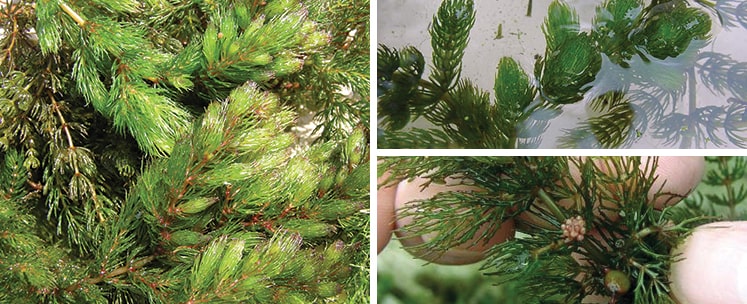Coontail

Description
Coontail is a submersed aquatic plant and can be easily identified by the "raccoon tail" cluster of leaves at the end of the main stalk. It has slender stems and leather-like leaves. Coontail is called hornwort when it is sold for aquarium decorations. It then spreads into ponds after aquariums are dumped into water bodies.
Other Names: Hornwort
Mechanical Control
Coontail can be removed by cutting and raking from the pond. It will regrow from remaining roots and seeds.
Pond Dye can be used to limit sunlight into the pond. With reduced sunlight, photosynthesis cannot occur so growth will be stunted.
Chemical Control
There are several options to control Coontail:
- Use a season long herbicide such as Airmax WipeOut or Sonar A.S.. One treatment treats Coontail and many other common pond weeds for the season.
- Use a broad spectrum contact herbicide, such as Ultra PondWeed Defense, will quickly kill Coontail. Because it does not stay in the water body, multiple treatments may be needed throughout the season.
- Use KnockDown Defense, a fast and selective herbicide that controls tough invasive and nuisance aquatic plants.
Chemical Application Best Practices
Anytime you use chemicals treat weeds and algae, please keep in mind the following:
- Treat your pond in sections. Treat only half the pond's surface at a time. During hot weather or when treating heavy growth, it is important to treat no more than 1/4 of your pond at a time and wait the full 14 days before re-applying. This helps lower the risk of fish loss during hot weather or when treating heavy growth.
- Once the weeds have browned & died, use a weed cutter & rake to remove as much dead material as possible. This prevents an accumulation of dead plant material and muck.
- Take a proactive approach to pond management. Use PondClear, MuckAway and Pond Dye to keep your pond looking great. For more information, see our article on the Airmax Ecosystem.
Ask an Expert
If you are unable to identify your pond weed(s) using our Weed ID Guide, follow this article to email us a photo.